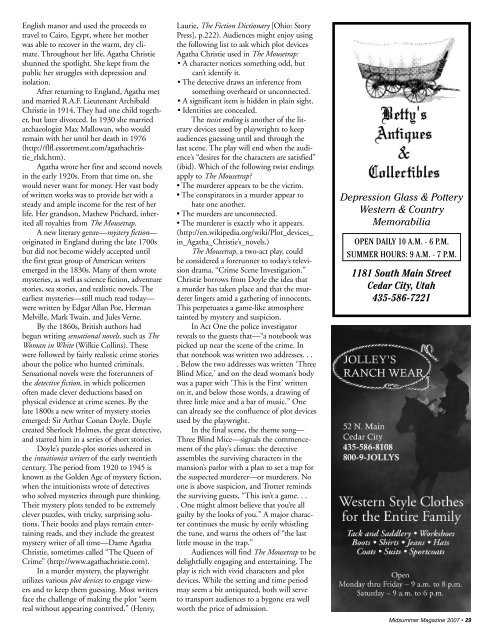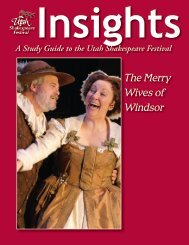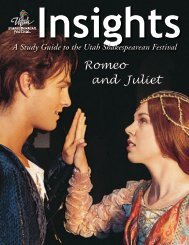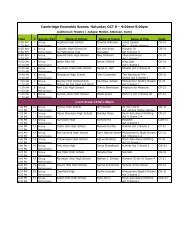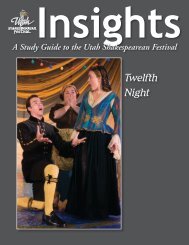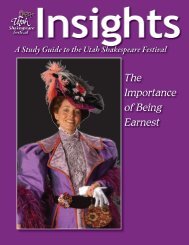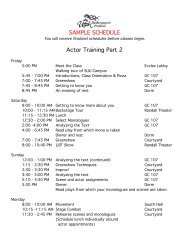Midsummer Magazine 2007 - Utah Shakespearean Festival
Midsummer Magazine 2007 - Utah Shakespearean Festival
Midsummer Magazine 2007 - Utah Shakespearean Festival
Create successful ePaper yourself
Turn your PDF publications into a flip-book with our unique Google optimized e-Paper software.
English manor and used the proceeds totravel to Cairo, Egypt, where her motherwas able to recover in the warm, dry climate.Throughout her life, Agatha Christieshunned the spotlight. She kept from thepublic her struggles with depression andisolation.After returning to England, Agatha metand married R.A.F. Lieutenant ArchibaldChristie in 1914. They had one child together,but later divorced. In 1930 she marriedarchaeologist Max Mallowan, who wouldremain with her until her death in 1976(http://flfl.essortment.com/agathachristie_rlxk.htm).Agatha wrote her first and second novelsin the early 1920s. From that time on, shewould never want for money. Her vast bodyof written works was to provide her with asteady and ample income for the rest of herlife. Her grandson, Mathew Prichard, inheritedall royalties from The Mousetrap.A new literary genre—mystery fiction—originated in England during the late 1700sbut did not become widely accepted untilthe first great group of American writersemerged in the 1830s. Many of them wrotemysteries, as well as science fiction, adventurestories, sea stories, and realistic novels. Theearliest mysteries—still much read today—were written by Edgar Allan Poe, HermanMelville, Mark Twain, and Jules Verne.By the 1860s, British authors hadbegun writing sensational novels, such as TheWoman in White (Wilkie Collins). Thesewere followed by fairly realistic crime storiesabout the police who hunted criminals.Sensational novels were the forerunners ofthe detective fiction, in which policemenoften made clever deductions based onphysical evidence at crime scenes. By thelate 1800s a new writer of mystery storiesemerged: Sir Arthur Conan Doyle. Doylecreated Sherlock Holmes, the great detective,and starred him in a series of short stories.Doyle’s puzzle-plot stories ushered inthe intuitionist writers of the early twentiethcentury. The period from 1920 to 1945 isknown as the Golden Age of mystery fiction,when the intuitionists wrote of detectiveswho solved mysteries through pure thinking.Their mystery plots tended to be extremelyclever puzzles, with tricky, surprising solutions.Their books and plays remain entertainingreads, and they include the greatestmystery writer of all time—Dame AgathaChristie, sometimes called “The Queen ofCrime” (http://www.agathachristie.com).In a murder mystery, the playwrightutilizes various plot devices to engage viewersand to keep them guessing. Most writersface the challenge of making the plot “seemreal without appearing contrived.” (Henry,Laurie, The Fiction Dictionary [Ohio: StoryPress], p.222). Audiences might enjoy usingthe following list to ask which plot devicesAgatha Christie used in The Mousetrap:• A character notices something odd, butcan’t identify it.• The detective draws an inference fromsomething overheard or unconnected.• A significant item is hidden in plain sight.• Identities are concealed.The twist ending is another of the literarydevices used by playwrights to keepaudiences guessing until and through thelast scene. The play will end when the audience’s“desires for the characters are satisfied”(ibid). Which of the following twist endingsapply to The Mousetrap?• The murderer appears to be the victim.• The conspirators in a murder appear tohate one another.• The murders are unconnected.• The murderer is exactly who it appears.(http://en.wikipedia.org/wiki/Plot_devices_in_Agatha_Christie’s_novels.)The Mousetrap, a two-act play, couldbe considered a forerunner to today’s televisiondrama, “Crime Scene Investigation.”Christie borrows from Doyle the idea thata murder has taken place and that the murdererlingers amid a gathering of innocents.This perpetuates a game-like atmospheretainted by mystery and suspicion.In Act One the police investigatorreveals to the guests that—“a notebook waspicked up near the scene of the crime. Inthat notebook was written two addresses. . .. Below the two addresses was written ‘ThreeBlind Mice,’ and on the dead woman’s bodywas a paper with ‘This is the First’ writtenon it, and below those words, a drawing ofthree little mice and a bar of music.” Onecan already see the confluence of plot devicesused by the playwright.In the final scene, the theme song—Three Blind Mice—signals the commencementof the play’s climax: the detectiveassembles the surviving characters in themansion’s parlor with a plan to set a trap forthe suspected murderer—or murderers. Noone is above suspicion, and Trotter remindsthe surviving guests, “This isn’t a game. . .. One might almost believe that you’re allguilty by the looks of you.” A major charactercontinues the music by eerily whistlingthe tune, and warns the others of “the lastlittle mouse in the trap.”Audiences will find The Mousetrap to bedelightfully engaging and entertaining. Theplay is rich with vivid characters and plotdevices. While the setting and time periodmay seem a bit antiquated, both will serveto transport audiences to a bygone era wellworth the price of admission.Depression Glass & PotteryWestern & CountryMemorabiliaOPEN DAILY 10 A.M. - 6 P.M.SUMMER HOURS: 9 A.M. - 7 P.M.1181 South Main StreetCedar City, <strong>Utah</strong>435-586-7221<strong>Midsummer</strong> <strong>Magazine</strong> <strong>2007</strong> • 29


